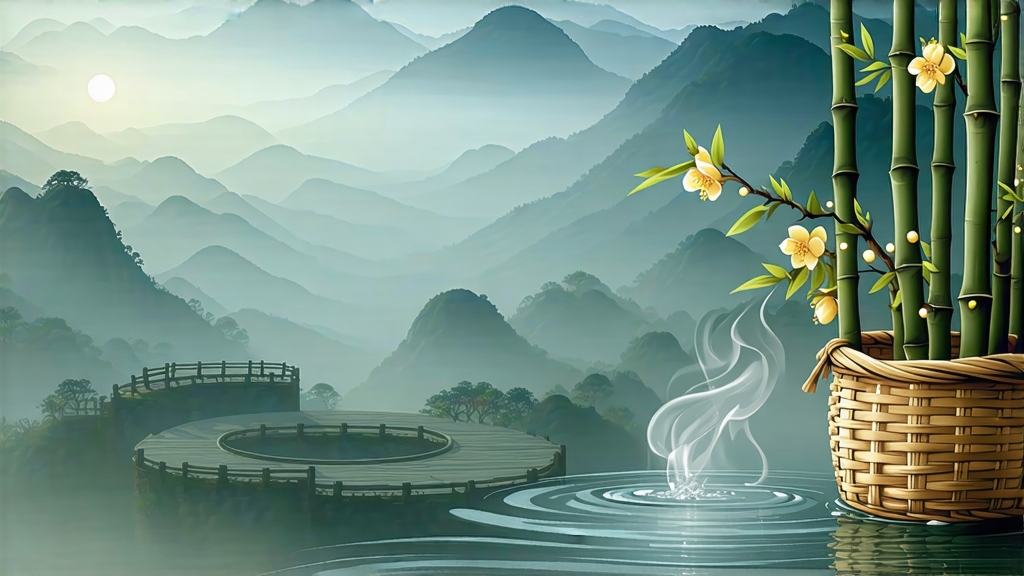
High above the Sichuan Basin, where moist clouds from the Tibetan Plateau collide with warm valley air, the ancient Meng Ding range has been shrouded in myth and tea fragrance for almost two millennia. Among the craggy limestone ridges lies Ganlu Temple, a modest monastery whose name—“Sweet Dew”—hints at the liquid treasure first cultivated by the monk Wu Lizhen in 53 BCE. Local chronicles claim that when the Tang emperor Li Shimin tasted the tiny, down-covered buds sent from these slopes, he declared them “yellow like imperial silk, fragrant like orchids born of dew,” thereby granting Meng Ding Huang Ya (蒙顶黄芽) a permanent seat on the tribute roster. From the Tang through the late Qing, each spring caravan of porters carried the freshly yellowed leaves along the Min River, over plank roads suspended from cliffs, to the courts of Chang’an, Kaifeng, Nanjing and Beijing. The tea vanished from palace menus after 1911, yet the mountain villagers quietly guarded both the old tea groves and the labor-intensive “sealed yellowing” technique that turns green buds into liquid topaz. Only since the 1980s has this lost imperial yellow tea re-emerged, winning gold medals at Brussels and Melbourne while still being hand-crafted in batches smaller than a single Bordeaux château’s annual wine.
Botanically, Meng Ding Huang Ya is a single-bud pick of the local Sichuan小叶 (small-leaf) landrace, a slow-growing Camellia sinensis var. sinensis that has acclimated to 1,000–1,400 m elevation, frequent fog and ultraviolet-rich sunlight. The variety develops extraordinarily high levels of theanine and soluble sugars, yet keeps polyphenols gently restrained—chemical conditions that later allow the “yellowing” enzymes to create mellow sweetness rather than grassy astringency. Spring buds are harvested only during the fifteen-day window when the first true leaf remains folded inside the downy casing, resembling a sleeping carp. One kilogram of finished tea needs roughly 8,000 such buds, all plucked before ten o’clock so that mountain dew does not add extra moisture that would complicate withering.
The craft sequence follows five classical steps, each calibrated to the mountain’s capricious weather. After an initial three-hour indoor wither on bamboo trays, the buds lose about 10 % moisture and acquire a faint grassy note. Next comes the kill-green, but at a lower pan temperature (140 °C) than green tea; the goal is to deactivate oxidative enzymes only partially, leaving enough biological activity for the signature yellowing. Within minutes the buds are wrapped in thin cotton pouches and placed inside a humid pine chamber kept at 28–30 °C. Here they rest for 70–90 minutes, during which residual heat and moisture trigger non-enzymatic browning and slight oxidation around the leaf edges, turning the originally jade tissue into a warm maize hue while developing a popcorn-like aroma. The cycle of gentle pan-heating and re-wrapping is repeated three times, each round softening tannins and coaxing out volatile compounds such as nerolidol and β-ionone that later translate into orchid and honey notes. Finally the leaves are given a low charcoal bake over embers of local cedar, reducing moisture to 5 % and locking in a shimmering golden color that seems to hold mountain sunshine.
Western tea tasters often ask how Meng Ding Huang Ya differs from a premium green tea such as Longjing. Visually the yellow bud is slimmer, the color deeper gold, and the trichomes more silvery under light. Aroma-wise green tea shouts fresh-cut grass and chestnut, whereas Huang Ya whispers steamed corn, fresh hay and a fleeting lychee florality. On the palate green tea attacks with brisk catechins, but Huang Ya circles the tongue with glycine-rich umami, followed by a cool, mint-tinged finish that Chinese texts call “sweet after the throat.” Chemically the yellowing step converts roughly 15 % of catechins into theaflavins and soluble thearubigins, cutting astringency by half while doubling soluble sugars—an elegant natural decaffeination that leaves the drinker clarified rather than buzzed.
To brew Meng Ding Huang Ya respectfully one needs mountain water, patience and restraint. Begin by pre-warming a tall glass or a 150 ml porcelain gaiwan; the transparency allows you to watch buds stand upright, then slowly sink like golden diving needles. Use 3 g of leaf (about two heaped